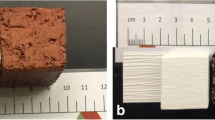Abstract
A phantom for the evaluation of electrokinetic remediation of radioactive species from water saturated concrete is described. The phantom has been designed to be a general analogue for environments where structural concrete is saturated by radioactive aqueous solutions and where electrokinetic remediation may be deployed. It is also a specific analogue for the walls of storage ponds for legacy spend nuclear fuel pins where the pond water comprises a large volume of hazardous active waste that may penetrate the pond wall. The fabricated phantom was evaluated using a fixed electrical potential to monitor the rate of cationic transport of K+ through concrete samples of different thickness (20 and 35 mm respectively). Results of the evaluation show K+ diffusion coefficients of 5.20 × 10−13 and 7.61 × 10−13 m2 s−1 for the 20 mm and 35 mm samples, consistent with those seen in literature for the transport of caesium through concrete of similar thickness. The phantom offers a means of experimental validation of computational electrokinetic models as well as providing a basis to test the effects of electrode material on ionic transport rates, to interrogate the effects of pH on all components of the system, and as a basis for instruction, education and training in nuclear decommissioning and waste treatment.








Similar content being viewed by others
References
Nuclear Decommissioning Authority (2010) The UK Radioactive Waste Inventory. www.nda.gov.uk/ukinventory/the_inventory/2010-inventory.cfm. Accessed 27 Jan 2014
McKie R (2009) Sellafield: the most hazardous place in Europe, the observer. http://www.theguardian.com/environment/2009/apr/19/sellafield-nuclear-plant-cumbria-hazards. Accessed 27 Jan 2014
Reddy KR, Cameselle C (2009) Electrochemical remediation technologies for polluted soils, sediments and groundwater, 1st edn. Wiley, New York
Sharp SR, Clemeña GG, Virmani YP, Stoner GE, Kelly RG (2002) Federal Highways Administration, US Department of Transport. www.fhwa.dot.gov/publications/research/infrastructure/structures/02107/. Accessed 27 Jan 2014
Reddy KR, Xu CY, Chinthamreddy S (2001) J Hazard Mater 84:279–296
Castellote M, Botija S (2011) J Appl Electrochem 41:695–703
Castellote M, Botija S, Andrade C (2010) J Appl Electrochem 40:1195–1208
Popov K, Glazkova I, Yachmenev V, Nikolayev A (2008) Enrivon Pollut 153:22–28
Bostick WD, Bush SA, Marsh GC, Henderson HM, Box WD, Morgan IL (1993) Electroosmotic decontamination of Concrete. ORNL, Tennessee, Report under DOE contract DE-AC05-84OR21400
Popov K, Glazkova I, Myagkov S, Petrov A, Sedykh E, Bannykh L, Yachmenev V (2007) Colloid Surf 299:198–202
Kim GN, Choi WK, Lee KW (2010) J Appl Electrochem 40:1209–1216
Yurchemko AY, Karlin YV, Nikolaev AN, Karlina OK, Barinov AS (2009) Atom Energy 106:225–230
Napier BA, Droppo JG, Rishel JP (2011) Pacific Northwest National Laboratory, US Department of Energy. http://www.pnl.gov/main/publications/external/technical_reports/PNNL-20173.pdf. Accessed 27 Jan 2014
Harris MT, DePaoli DW, Ally MR (1997) Sep Purif Technol 11:173–184
Lima-Ferreira FC, Souza DDN (2011) Nucl Instrum Methods 652:791–793
Cerqueira RAD, Maia F (2012) Radiat Phys Chem 95:174–176
Gonzaga NB, Mourão AP, Magalhães MJ, Silva TA (2013) Appl Radiat Isotopes 83:242–244
Shippen BA, Joyce MJ (2011) Nucl Eng Des 241:526–532
Castellote M, Andrade C, Alonso C (2002) Environ Sci Technol 36:2256–2261
Parker AJ, Boxall C, Joyce MJ (2013) J Radioanal Nucl Chem 295:797–802
Sellafield Integrated Waste Strategy—Update to Version 2 (2008) Sellafield Sites Ltd, Cumbria. http://www.sellafieldsites.com/wp-content/uploads/2012/08/Integrated-Waste-Strat-update-to-V2.pdf. Accessed 27 Jan 2014
Parker AJ, Boxall C, Joyce MJ (2013) Nucl Instrum Method 722:5–10
Andrade C (1993) Cem Concr Res 23:724–742
Frizon F, Lorente S, Auzuech C (2005) Cem Concr Res 35:2018–2025
Arsenault J (1999) PhD thesis, University of Laval, Canada. http://www-lmdc.insa-toulouse.fr/etud/theses/%25pdf-Arsenault.pdf. Accessed 27 Jan 2014
Volchek K, Miah MY, Kuang W, DeMaleki Z, Tezel FH (2011) J Hazard Mater 194:331–337
Lavi N, Groppi F, Alfassi ZB (2004) Radiat Meas 38:139–143
Akhavan A, Shafaatian SMH, Rajabipour F (2012) Cem Concr Res 42:313–320
Elakneswaran Y, Iwasa A, Nawa T, Sato T, Kurumisawa K (2010) Cem Concr Res 40:1756–1765
DePaoli DW, Harris MT, Morgan IL, Ally MR (1997) Sep Sci Technol 32:387–404
Acknowledgments
This work was funded by the United Kingdom’s Nuclear Decommissioning Authority (NDA) through a PhD bursary for Andrew Parker. Colin Boxall is supported by the Lloyd’s Register Foundation, an independent charity that supports the advancement of engineering related education, and funds research and development that enhances the safety of life at sea, on land and in the air. Further thanks go to Pete Jones for helping in the fabrication of the phantom.
Author information
Authors and Affiliations
Corresponding author
Rights and permissions
About this article
Cite this article
Parker, A.J., Joyce, M.J. & Boxall, C. A radioanalytical phantom for assessing the efficacy of electrokinetic decontamination of entrained radioactivity within concrete media. J Radioanal Nucl Chem 300, 769–777 (2014). https://doi.org/10.1007/s10967-014-3015-3
Received:
Published:
Issue Date:
DOI: https://doi.org/10.1007/s10967-014-3015-3




